Comprehensive Report on Financial Management, Statements & Ratios
VerifiedAdded on 2023/06/17
|13
|2688
|140
Report
AI Summary
This report provides a comprehensive overview of financial management, defining its core concepts and highlighting its importance in improving profitability, facilitating financial planning, aiding decision-making, expanding firm value, and ensuring appropriate fund utilization. It delves into financial statements, including the balance sheet, income statement, and cash flow statement, explaining their structure and utility in assessing a company's financial health. The report also includes a practical application using provided templates to analyze a sample organization's performance, focusing on profitability, liquidity, and efficiency through ratio analysis. Furthermore, it discusses potential processes a business can implement to enhance its financial performance, such as improving marketing techniques, optimizing expenses, and eliminating wasteful expenditures. The conclusion emphasizes the essential role of financial management in gaining a competitive advantage through effective fund utilization and resource management.

Importance of
financial management
financial management
Paraphrase This Document
Need a fresh take? Get an instant paraphrase of this document with our AI Paraphraser
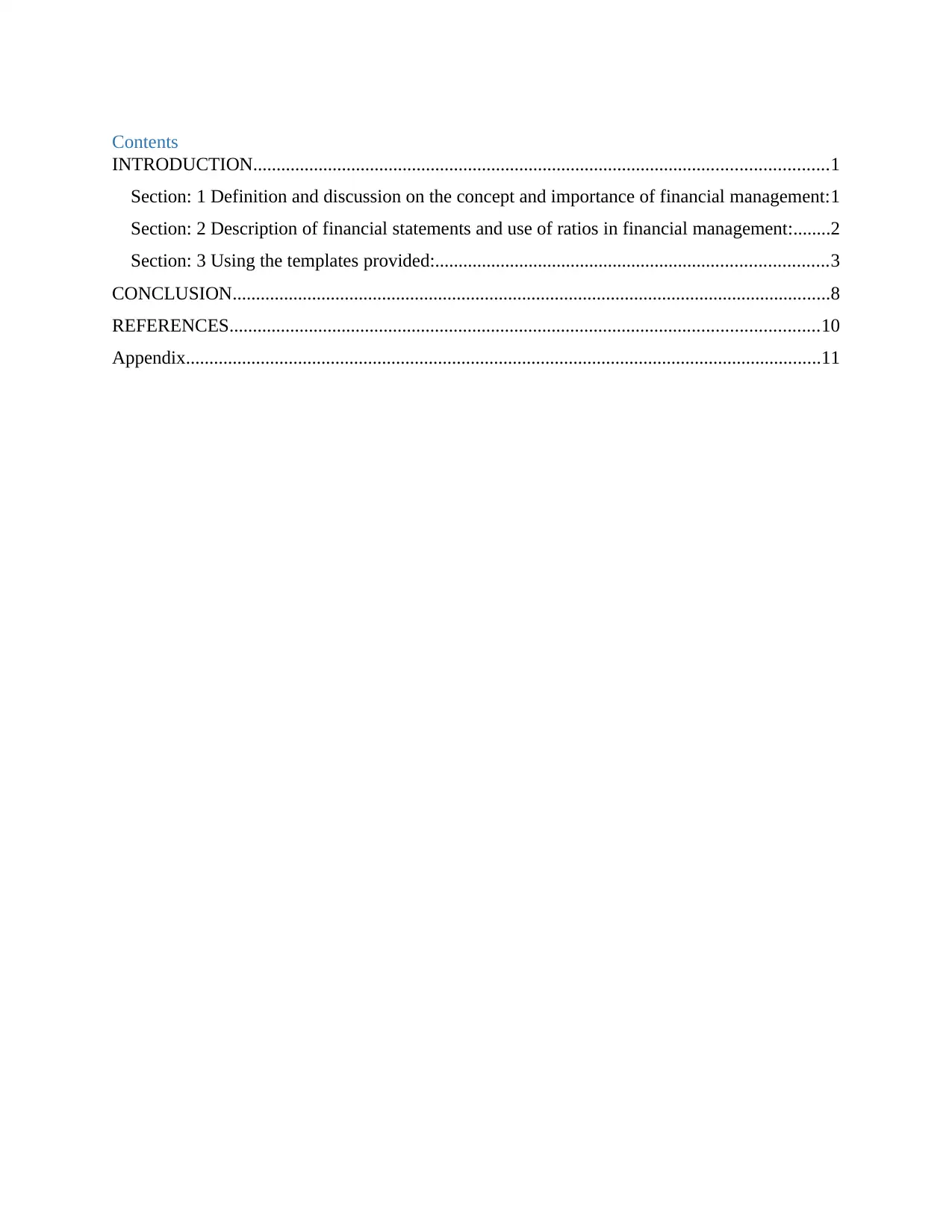
Contents
INTRODUCTION...........................................................................................................................1
Section: 1 Definition and discussion on the concept and importance of financial management:1
Section: 2 Description of financial statements and use of ratios in financial management:........2
Section: 3 Using the templates provided:....................................................................................3
CONCLUSION................................................................................................................................8
REFERENCES..............................................................................................................................10
Appendix........................................................................................................................................11
INTRODUCTION...........................................................................................................................1
Section: 1 Definition and discussion on the concept and importance of financial management:1
Section: 2 Description of financial statements and use of ratios in financial management:........2
Section: 3 Using the templates provided:....................................................................................3
CONCLUSION................................................................................................................................8
REFERENCES..............................................................................................................................10
Appendix........................................................................................................................................11
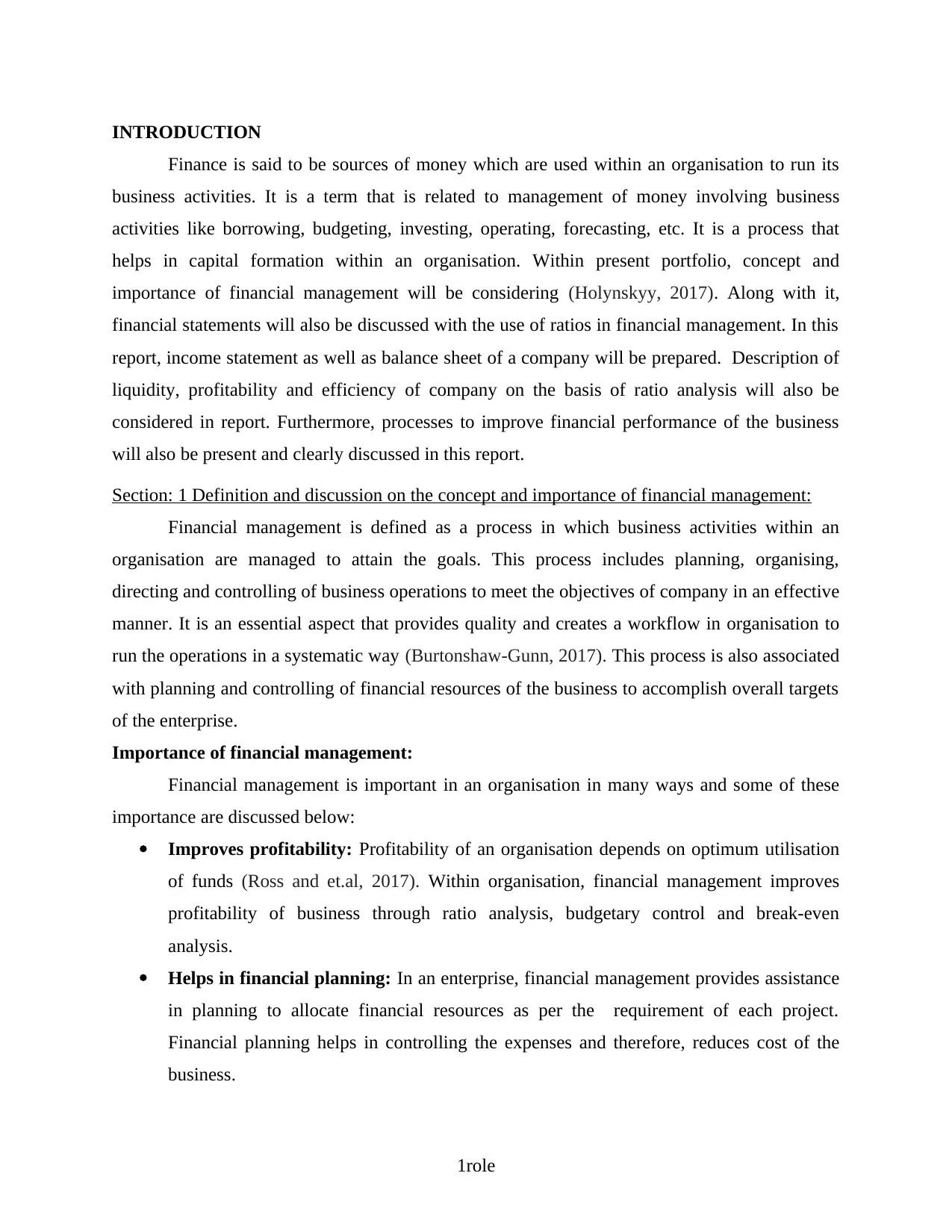
INTRODUCTION
Finance is said to be sources of money which are used within an organisation to run its
business activities. It is a term that is related to management of money involving business
activities like borrowing, budgeting, investing, operating, forecasting, etc. It is a process that
helps in capital formation within an organisation. Within present portfolio, concept and
importance of financial management will be considering (Holynskyy, 2017). Along with it,
financial statements will also be discussed with the use of ratios in financial management. In this
report, income statement as well as balance sheet of a company will be prepared. Description of
liquidity, profitability and efficiency of company on the basis of ratio analysis will also be
considered in report. Furthermore, processes to improve financial performance of the business
will also be present and clearly discussed in this report.
Section: 1 Definition and discussion on the concept and importance of financial management:
Financial management is defined as a process in which business activities within an
organisation are managed to attain the goals. This process includes planning, organising,
directing and controlling of business operations to meet the objectives of company in an effective
manner. It is an essential aspect that provides quality and creates a workflow in organisation to
run the operations in a systematic way (Burtonshaw-Gunn, 2017). This process is also associated
with planning and controlling of financial resources of the business to accomplish overall targets
of the enterprise.
Importance of financial management:
Financial management is important in an organisation in many ways and some of these
importance are discussed below:
Improves profitability: Profitability of an organisation depends on optimum utilisation
of funds (Ross and et.al, 2017). Within organisation, financial management improves
profitability of business through ratio analysis, budgetary control and break-even
analysis.
Helps in financial planning: In an enterprise, financial management provides assistance
in planning to allocate financial resources as per the requirement of each project.
Financial planning helps in controlling the expenses and therefore, reduces cost of the
business.
1role
Finance is said to be sources of money which are used within an organisation to run its
business activities. It is a term that is related to management of money involving business
activities like borrowing, budgeting, investing, operating, forecasting, etc. It is a process that
helps in capital formation within an organisation. Within present portfolio, concept and
importance of financial management will be considering (Holynskyy, 2017). Along with it,
financial statements will also be discussed with the use of ratios in financial management. In this
report, income statement as well as balance sheet of a company will be prepared. Description of
liquidity, profitability and efficiency of company on the basis of ratio analysis will also be
considered in report. Furthermore, processes to improve financial performance of the business
will also be present and clearly discussed in this report.
Section: 1 Definition and discussion on the concept and importance of financial management:
Financial management is defined as a process in which business activities within an
organisation are managed to attain the goals. This process includes planning, organising,
directing and controlling of business operations to meet the objectives of company in an effective
manner. It is an essential aspect that provides quality and creates a workflow in organisation to
run the operations in a systematic way (Burtonshaw-Gunn, 2017). This process is also associated
with planning and controlling of financial resources of the business to accomplish overall targets
of the enterprise.
Importance of financial management:
Financial management is important in an organisation in many ways and some of these
importance are discussed below:
Improves profitability: Profitability of an organisation depends on optimum utilisation
of funds (Ross and et.al, 2017). Within organisation, financial management improves
profitability of business through ratio analysis, budgetary control and break-even
analysis.
Helps in financial planning: In an enterprise, financial management provides assistance
in planning to allocate financial resources as per the requirement of each project.
Financial planning helps in controlling the expenses and therefore, reduces cost of the
business.
1role
⊘ This is a preview!⊘
Do you want full access?
Subscribe today to unlock all pages.

Trusted by 1+ million students worldwide
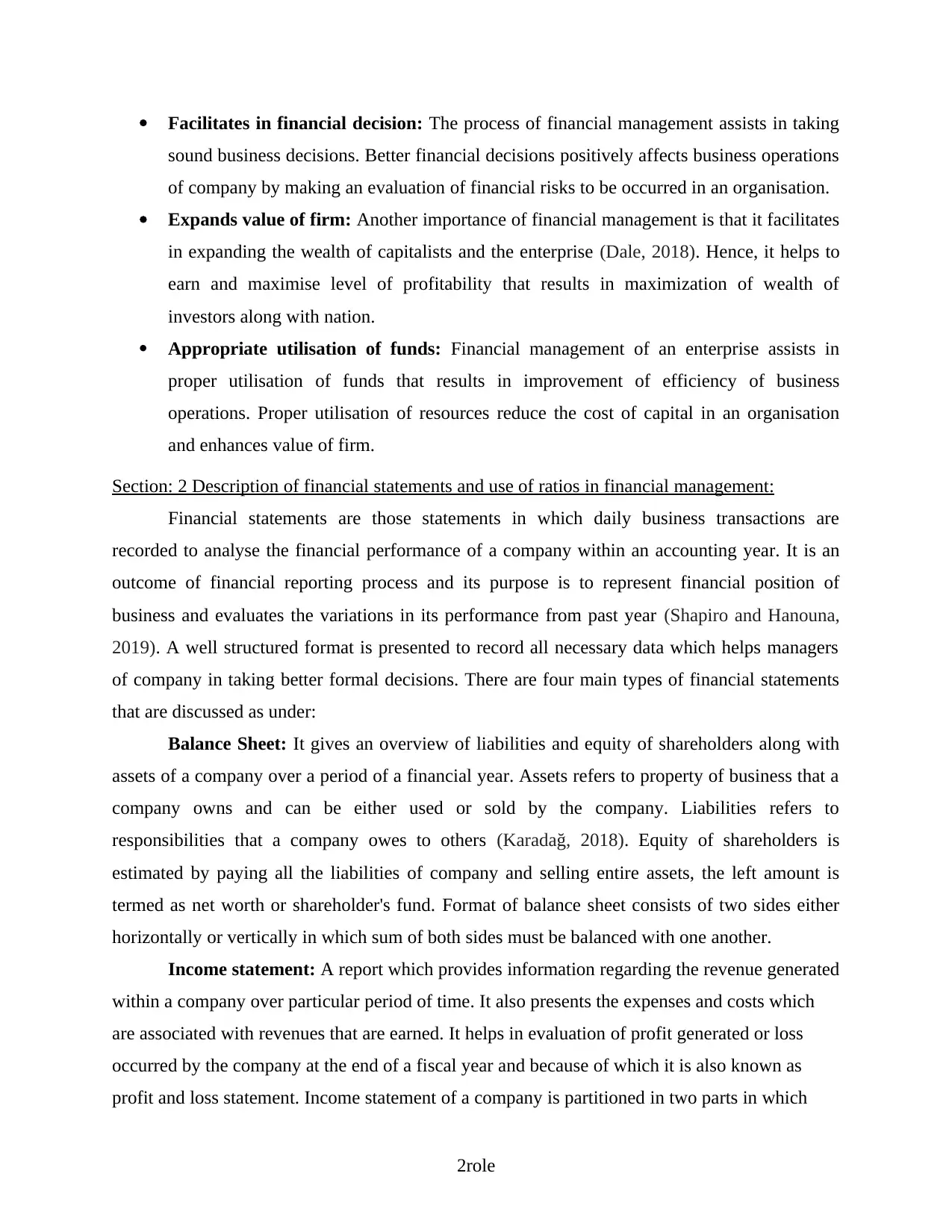
Facilitates in financial decision: The process of financial management assists in taking
sound business decisions. Better financial decisions positively affects business operations
of company by making an evaluation of financial risks to be occurred in an organisation.
Expands value of firm: Another importance of financial management is that it facilitates
in expanding the wealth of capitalists and the enterprise (Dale, 2018). Hence, it helps to
earn and maximise level of profitability that results in maximization of wealth of
investors along with nation.
Appropriate utilisation of funds: Financial management of an enterprise assists in
proper utilisation of funds that results in improvement of efficiency of business
operations. Proper utilisation of resources reduce the cost of capital in an organisation
and enhances value of firm.
Section: 2 Description of financial statements and use of ratios in financial management:
Financial statements are those statements in which daily business transactions are
recorded to analyse the financial performance of a company within an accounting year. It is an
outcome of financial reporting process and its purpose is to represent financial position of
business and evaluates the variations in its performance from past year (Shapiro and Hanouna,
2019). A well structured format is presented to record all necessary data which helps managers
of company in taking better formal decisions. There are four main types of financial statements
that are discussed as under:
Balance Sheet: It gives an overview of liabilities and equity of shareholders along with
assets of a company over a period of a financial year. Assets refers to property of business that a
company owns and can be either used or sold by the company. Liabilities refers to
responsibilities that a company owes to others (Karadağ, 2018). Equity of shareholders is
estimated by paying all the liabilities of company and selling entire assets, the left amount is
termed as net worth or shareholder's fund. Format of balance sheet consists of two sides either
horizontally or vertically in which sum of both sides must be balanced with one another.
Income statement: A report which provides information regarding the revenue generated
within a company over particular period of time. It also presents the expenses and costs which
are associated with revenues that are earned. It helps in evaluation of profit generated or loss
occurred by the company at the end of a fiscal year and because of which it is also known as
profit and loss statement. Income statement of a company is partitioned in two parts in which
2role
sound business decisions. Better financial decisions positively affects business operations
of company by making an evaluation of financial risks to be occurred in an organisation.
Expands value of firm: Another importance of financial management is that it facilitates
in expanding the wealth of capitalists and the enterprise (Dale, 2018). Hence, it helps to
earn and maximise level of profitability that results in maximization of wealth of
investors along with nation.
Appropriate utilisation of funds: Financial management of an enterprise assists in
proper utilisation of funds that results in improvement of efficiency of business
operations. Proper utilisation of resources reduce the cost of capital in an organisation
and enhances value of firm.
Section: 2 Description of financial statements and use of ratios in financial management:
Financial statements are those statements in which daily business transactions are
recorded to analyse the financial performance of a company within an accounting year. It is an
outcome of financial reporting process and its purpose is to represent financial position of
business and evaluates the variations in its performance from past year (Shapiro and Hanouna,
2019). A well structured format is presented to record all necessary data which helps managers
of company in taking better formal decisions. There are four main types of financial statements
that are discussed as under:
Balance Sheet: It gives an overview of liabilities and equity of shareholders along with
assets of a company over a period of a financial year. Assets refers to property of business that a
company owns and can be either used or sold by the company. Liabilities refers to
responsibilities that a company owes to others (Karadağ, 2018). Equity of shareholders is
estimated by paying all the liabilities of company and selling entire assets, the left amount is
termed as net worth or shareholder's fund. Format of balance sheet consists of two sides either
horizontally or vertically in which sum of both sides must be balanced with one another.
Income statement: A report which provides information regarding the revenue generated
within a company over particular period of time. It also presents the expenses and costs which
are associated with revenues that are earned. It helps in evaluation of profit generated or loss
occurred by the company at the end of a fiscal year and because of which it is also known as
profit and loss statement. Income statement of a company is partitioned in two parts in which
2role
Paraphrase This Document
Need a fresh take? Get an instant paraphrase of this document with our AI Paraphraser
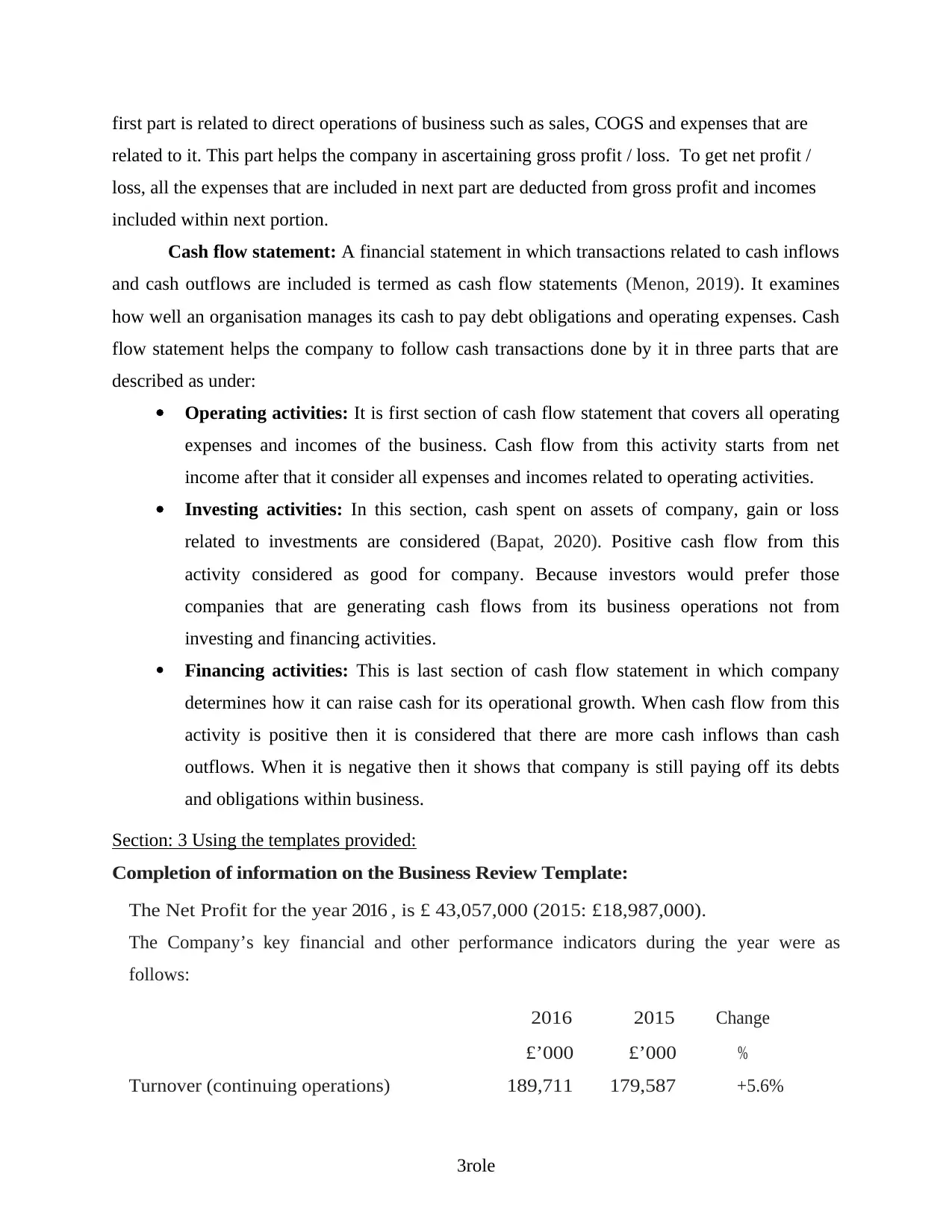
first part is related to direct operations of business such as sales, COGS and expenses that are
related to it. This part helps the company in ascertaining gross profit / loss. To get net profit /
loss, all the expenses that are included in next part are deducted from gross profit and incomes
included within next portion.
Cash flow statement: A financial statement in which transactions related to cash inflows
and cash outflows are included is termed as cash flow statements (Menon, 2019). It examines
how well an organisation manages its cash to pay debt obligations and operating expenses. Cash
flow statement helps the company to follow cash transactions done by it in three parts that are
described as under:
Operating activities: It is first section of cash flow statement that covers all operating
expenses and incomes of the business. Cash flow from this activity starts from net
income after that it consider all expenses and incomes related to operating activities.
Investing activities: In this section, cash spent on assets of company, gain or loss
related to investments are considered (Bapat, 2020). Positive cash flow from this
activity considered as good for company. Because investors would prefer those
companies that are generating cash flows from its business operations not from
investing and financing activities.
Financing activities: This is last section of cash flow statement in which company
determines how it can raise cash for its operational growth. When cash flow from this
activity is positive then it is considered that there are more cash inflows than cash
outflows. When it is negative then it shows that company is still paying off its debts
and obligations within business.
Section: 3 Using the templates provided:
Completion of information on the Business Review Template:
The Net Profit for the year 2016 , is £ 43,057,000 (2015: £18,987,000).
The Company’s key financial and other performance indicators during the year were as
follows:
2016
£’000
2015
£’000
Change
%
Turnover (continuing operations) 189,711 179,587 +5.6%
3role
related to it. This part helps the company in ascertaining gross profit / loss. To get net profit /
loss, all the expenses that are included in next part are deducted from gross profit and incomes
included within next portion.
Cash flow statement: A financial statement in which transactions related to cash inflows
and cash outflows are included is termed as cash flow statements (Menon, 2019). It examines
how well an organisation manages its cash to pay debt obligations and operating expenses. Cash
flow statement helps the company to follow cash transactions done by it in three parts that are
described as under:
Operating activities: It is first section of cash flow statement that covers all operating
expenses and incomes of the business. Cash flow from this activity starts from net
income after that it consider all expenses and incomes related to operating activities.
Investing activities: In this section, cash spent on assets of company, gain or loss
related to investments are considered (Bapat, 2020). Positive cash flow from this
activity considered as good for company. Because investors would prefer those
companies that are generating cash flows from its business operations not from
investing and financing activities.
Financing activities: This is last section of cash flow statement in which company
determines how it can raise cash for its operational growth. When cash flow from this
activity is positive then it is considered that there are more cash inflows than cash
outflows. When it is negative then it shows that company is still paying off its debts
and obligations within business.
Section: 3 Using the templates provided:
Completion of information on the Business Review Template:
The Net Profit for the year 2016 , is £ 43,057,000 (2015: £18,987,000).
The Company’s key financial and other performance indicators during the year were as
follows:
2016
£’000
2015
£’000
Change
%
Turnover (continuing operations) 189,711 179,587 +5.6%
3role
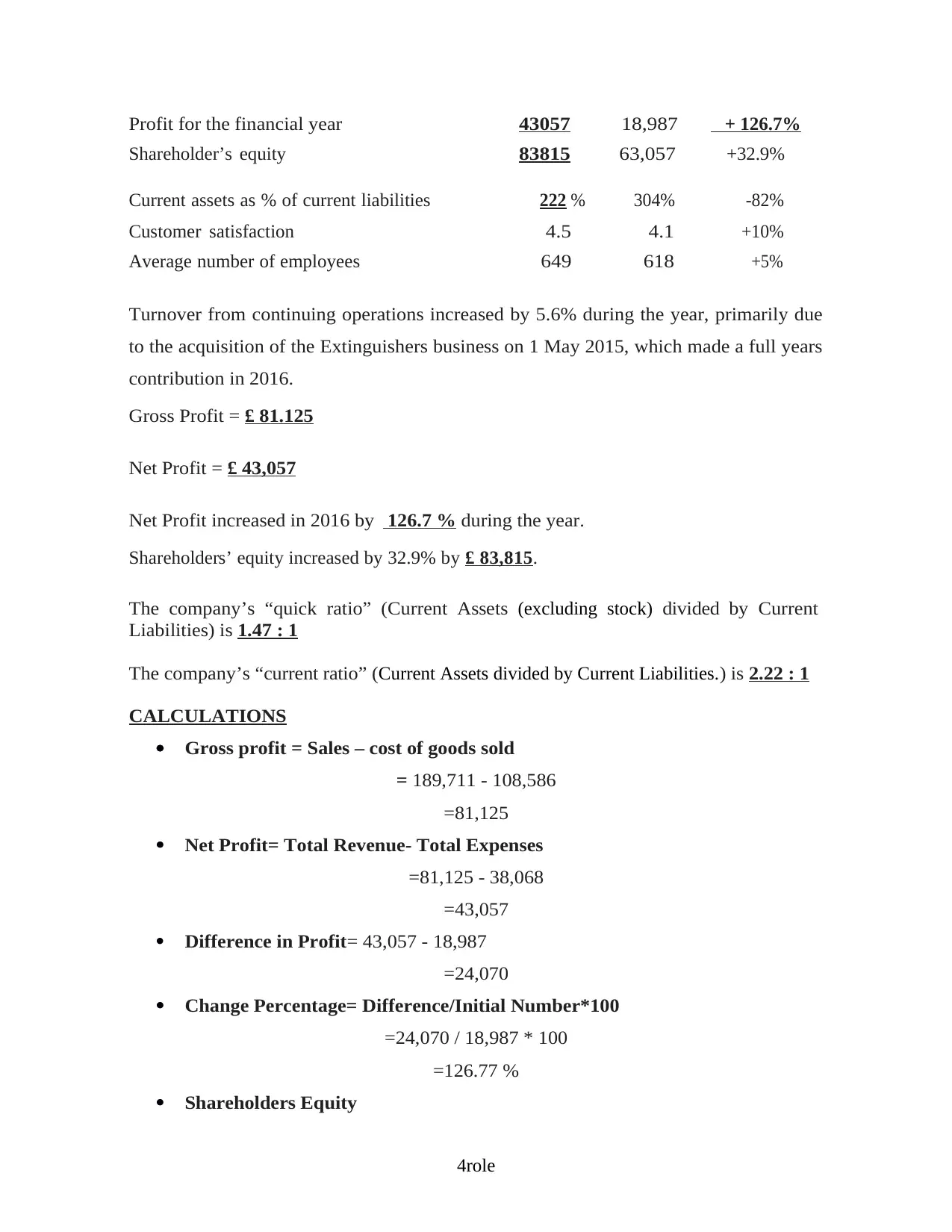
Profit for the financial year 43057 18,987 + 126.7%
Shareholder’s equity 83815 63,057 +32.9%
Current assets as % of current liabilities 222 % 304% -82%
Customer satisfaction 4.5 4.1 +10%
Average number of employees 649 618 +5%
Turnover from continuing operations increased by 5.6% during the year, primarily due
to the acquisition of the Extinguishers business on 1 May 2015, which made a full years
contribution in 2016.
Gross Profit = £ 81.125
Net Profit = £ 43,057
Net Profit increased in 2016 by 126.7 % during the year.
Shareholders’ equity increased by 32.9% by £ 83,815.
The company’s “quick ratio” (Current Assets (excluding stock) divided by Current
Liabilities) is 1.47 : 1
The company’s “current ratio” (Current Assets divided by Current Liabilities. ) is 2.22 : 1
CALCULATIONS
Gross profit = Sales – cost of goods sold
= 189,711 - 108,586
=81,125
Net Profit= Total Revenue- Total Expenses
=81,125 - 38,068
=43,057
Difference in Profit= 43,057 - 18,987
=24,070
Change Percentage= Difference/Initial Number*100
=24,070 / 18,987 * 100
=126.77 %
Shareholders Equity
4role
Shareholder’s equity 83815 63,057 +32.9%
Current assets as % of current liabilities 222 % 304% -82%
Customer satisfaction 4.5 4.1 +10%
Average number of employees 649 618 +5%
Turnover from continuing operations increased by 5.6% during the year, primarily due
to the acquisition of the Extinguishers business on 1 May 2015, which made a full years
contribution in 2016.
Gross Profit = £ 81.125
Net Profit = £ 43,057
Net Profit increased in 2016 by 126.7 % during the year.
Shareholders’ equity increased by 32.9% by £ 83,815.
The company’s “quick ratio” (Current Assets (excluding stock) divided by Current
Liabilities) is 1.47 : 1
The company’s “current ratio” (Current Assets divided by Current Liabilities. ) is 2.22 : 1
CALCULATIONS
Gross profit = Sales – cost of goods sold
= 189,711 - 108,586
=81,125
Net Profit= Total Revenue- Total Expenses
=81,125 - 38,068
=43,057
Difference in Profit= 43,057 - 18,987
=24,070
Change Percentage= Difference/Initial Number*100
=24,070 / 18,987 * 100
=126.77 %
Shareholders Equity
4role
⊘ This is a preview!⊘
Do you want full access?
Subscribe today to unlock all pages.

Trusted by 1+ million students worldwide
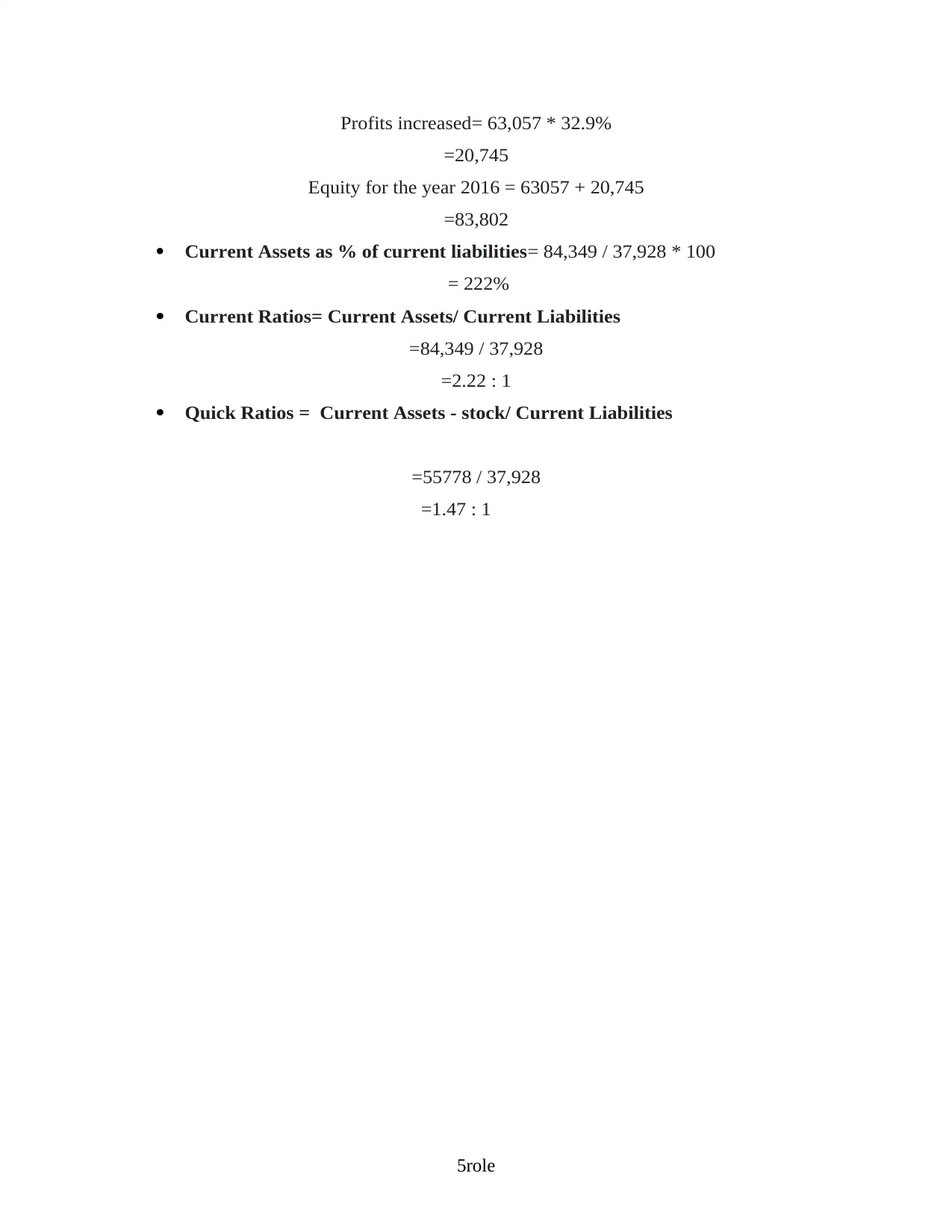
Profits increased= 63,057 * 32.9%
=20,745
Equity for the year 2016 = 63057 + 20,745
=83,802
Current Assets as % of current liabilities= 84,349 / 37,928 * 100
= 222%
Current Ratios= Current Assets/ Current Liabilities
=84,349 / 37,928
=2.22 : 1
Quick Ratios = Current Assets - stock/ Current Liabilities
=55778 / 37,928
=1.47 : 1
5role
=20,745
Equity for the year 2016 = 63057 + 20,745
=83,802
Current Assets as % of current liabilities= 84,349 / 37,928 * 100
= 222%
Current Ratios= Current Assets/ Current Liabilities
=84,349 / 37,928
=2.22 : 1
Quick Ratios = Current Assets - stock/ Current Liabilities
=55778 / 37,928
=1.47 : 1
5role
Paraphrase This Document
Need a fresh take? Get an instant paraphrase of this document with our AI Paraphraser
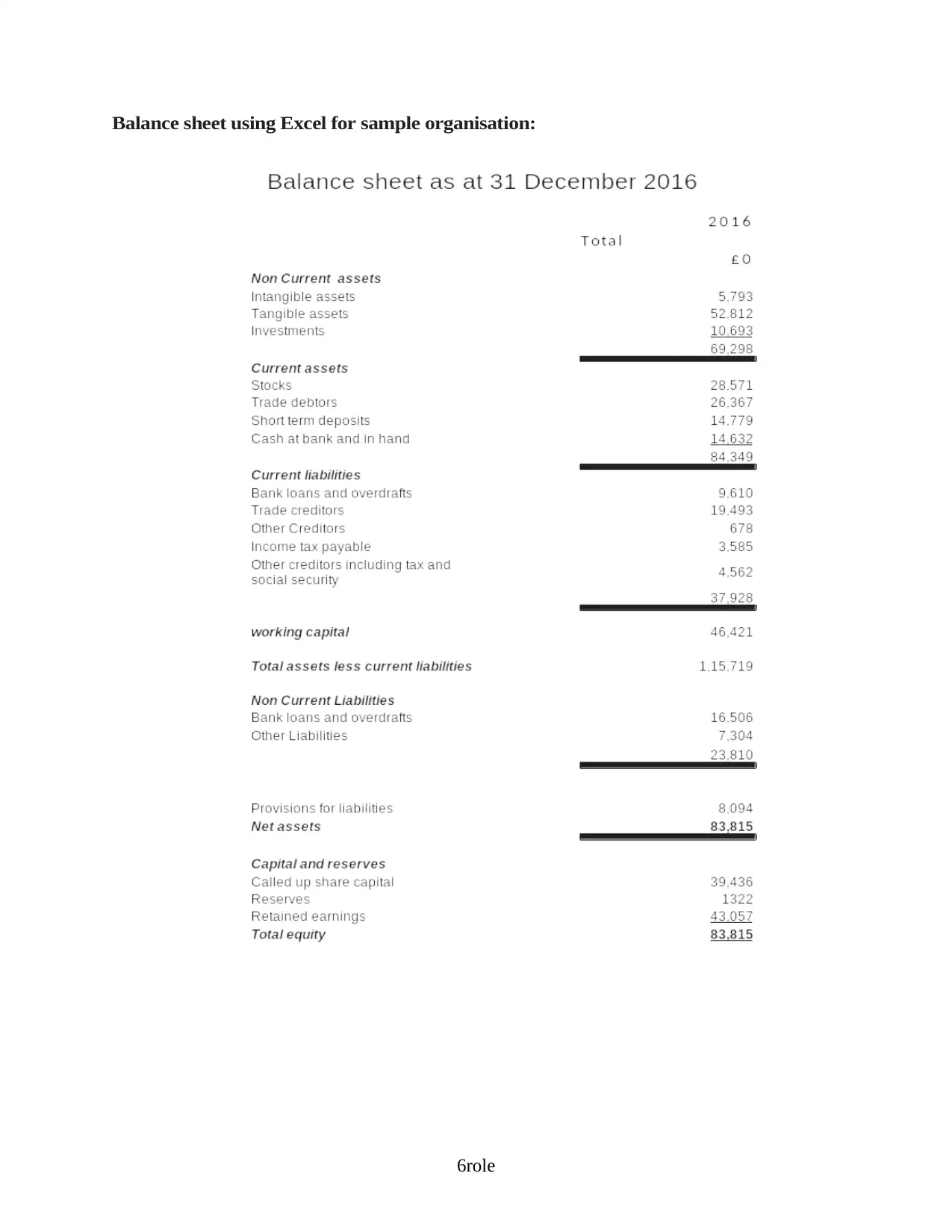
Balance sheet using Excel for sample organisation:
6role
6role
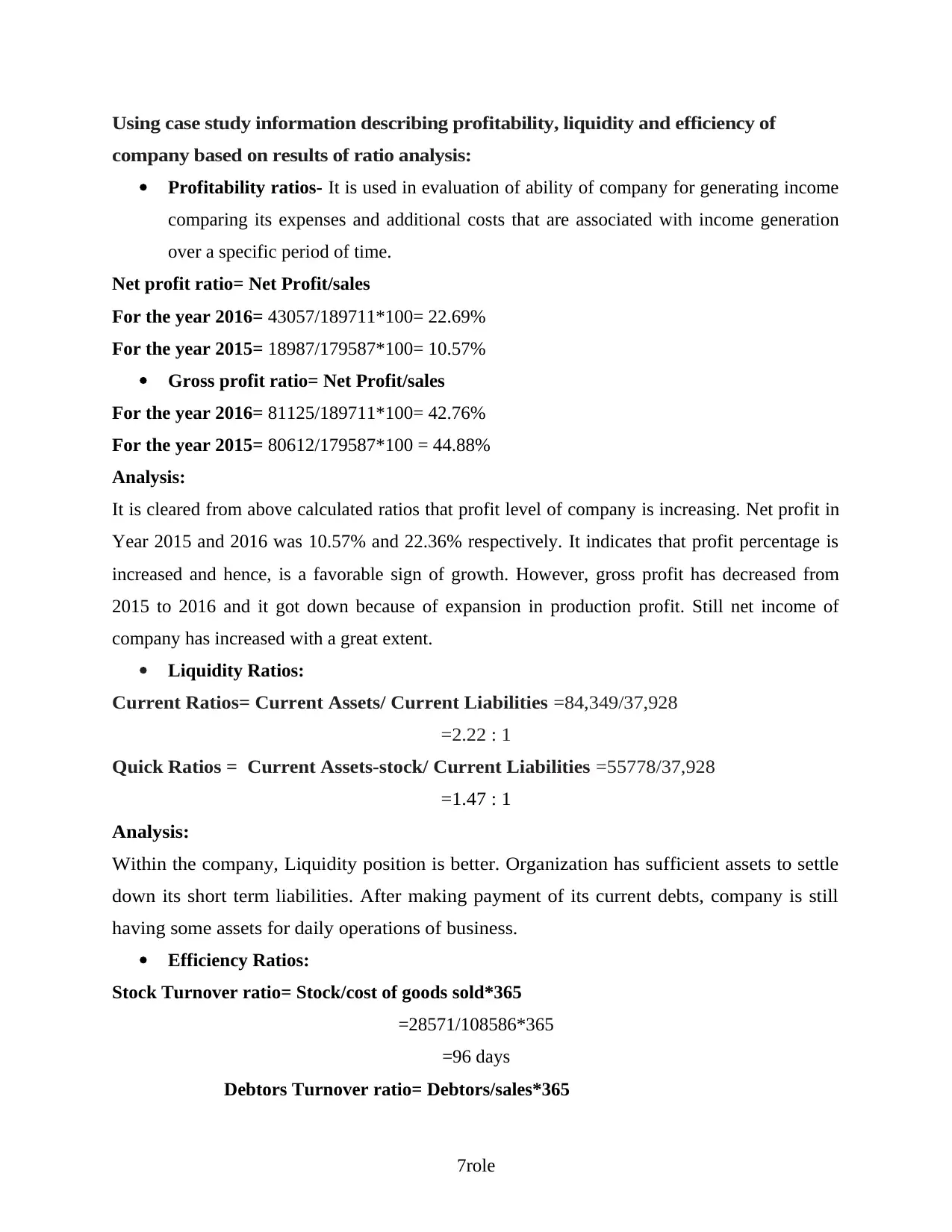
Using case study information describing profitability, liquidity and efficiency of
company based on results of ratio analysis:
Profitability ratios- It is used in evaluation of ability of company for generating income
comparing its expenses and additional costs that are associated with income generation
over a specific period of time.
Net profit ratio= Net Profit/sales
For the year 2016= 43057/189711*100= 22.69%
For the year 2015= 18987/179587*100= 10.57%
Gross profit ratio= Net Profit/sales
For the year 2016= 81125/189711*100= 42.76%
For the year 2015= 80612/179587*100 = 44.88%
Analysis:
It is cleared from above calculated ratios that profit level of company is increasing. Net profit in
Year 2015 and 2016 was 10.57% and 22.36% respectively. It indicates that profit percentage is
increased and hence, is a favorable sign of growth. However, gross profit has decreased from
2015 to 2016 and it got down because of expansion in production profit. Still net income of
company has increased with a great extent.
Liquidity Ratios:
Current Ratios= Current Assets/ Current Liabilities =84,349/37,928
=2.22 : 1
Quick Ratios = Current Assets-stock/ Current Liabilities =55778/37,928
=1.47 : 1
Analysis:
Within the company, Liquidity position is better. Organization has sufficient assets to settle
down its short term liabilities. After making payment of its current debts, company is still
having some assets for daily operations of business.
Efficiency Ratios:
Stock Turnover ratio= Stock/cost of goods sold*365
=28571/108586*365
=96 days
Debtors Turnover ratio= Debtors/sales*365
7role
company based on results of ratio analysis:
Profitability ratios- It is used in evaluation of ability of company for generating income
comparing its expenses and additional costs that are associated with income generation
over a specific period of time.
Net profit ratio= Net Profit/sales
For the year 2016= 43057/189711*100= 22.69%
For the year 2015= 18987/179587*100= 10.57%
Gross profit ratio= Net Profit/sales
For the year 2016= 81125/189711*100= 42.76%
For the year 2015= 80612/179587*100 = 44.88%
Analysis:
It is cleared from above calculated ratios that profit level of company is increasing. Net profit in
Year 2015 and 2016 was 10.57% and 22.36% respectively. It indicates that profit percentage is
increased and hence, is a favorable sign of growth. However, gross profit has decreased from
2015 to 2016 and it got down because of expansion in production profit. Still net income of
company has increased with a great extent.
Liquidity Ratios:
Current Ratios= Current Assets/ Current Liabilities =84,349/37,928
=2.22 : 1
Quick Ratios = Current Assets-stock/ Current Liabilities =55778/37,928
=1.47 : 1
Analysis:
Within the company, Liquidity position is better. Organization has sufficient assets to settle
down its short term liabilities. After making payment of its current debts, company is still
having some assets for daily operations of business.
Efficiency Ratios:
Stock Turnover ratio= Stock/cost of goods sold*365
=28571/108586*365
=96 days
Debtors Turnover ratio= Debtors/sales*365
7role
⊘ This is a preview!⊘
Do you want full access?
Subscribe today to unlock all pages.

Trusted by 1+ million students worldwide
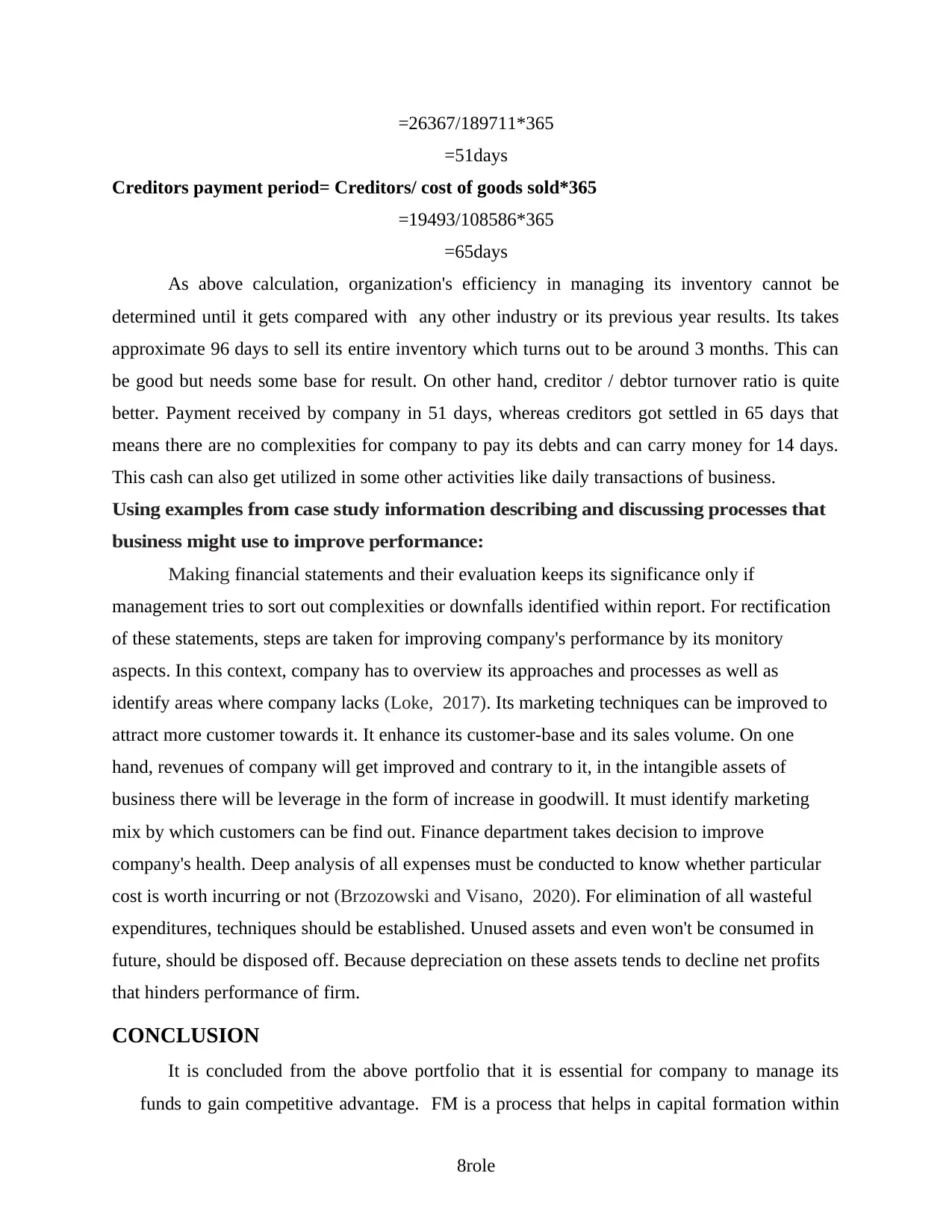
=26367/189711*365
=51days
Creditors payment period= Creditors/ cost of goods sold*365
=19493/108586*365
=65days
As above calculation, organization's efficiency in managing its inventory cannot be
determined until it gets compared with any other industry or its previous year results. Its takes
approximate 96 days to sell its entire inventory which turns out to be around 3 months. This can
be good but needs some base for result. On other hand, creditor / debtor turnover ratio is quite
better. Payment received by company in 51 days, whereas creditors got settled in 65 days that
means there are no complexities for company to pay its debts and can carry money for 14 days.
This cash can also get utilized in some other activities like daily transactions of business.
Using examples from case study information describing and discussing processes that
business might use to improve performance:
Making financial statements and their evaluation keeps its significance only if
management tries to sort out complexities or downfalls identified within report. For rectification
of these statements, steps are taken for improving company's performance by its monitory
aspects. In this context, company has to overview its approaches and processes as well as
identify areas where company lacks (Loke, 2017). Its marketing techniques can be improved to
attract more customer towards it. It enhance its customer-base and its sales volume. On one
hand, revenues of company will get improved and contrary to it, in the intangible assets of
business there will be leverage in the form of increase in goodwill. It must identify marketing
mix by which customers can be find out. Finance department takes decision to improve
company's health. Deep analysis of all expenses must be conducted to know whether particular
cost is worth incurring or not (Brzozowski and Visano, 2020). For elimination of all wasteful
expenditures, techniques should be established. Unused assets and even won't be consumed in
future, should be disposed off. Because depreciation on these assets tends to decline net profits
that hinders performance of firm.
CONCLUSION
It is concluded from the above portfolio that it is essential for company to manage its
funds to gain competitive advantage. FM is a process that helps in capital formation within
8role
=51days
Creditors payment period= Creditors/ cost of goods sold*365
=19493/108586*365
=65days
As above calculation, organization's efficiency in managing its inventory cannot be
determined until it gets compared with any other industry or its previous year results. Its takes
approximate 96 days to sell its entire inventory which turns out to be around 3 months. This can
be good but needs some base for result. On other hand, creditor / debtor turnover ratio is quite
better. Payment received by company in 51 days, whereas creditors got settled in 65 days that
means there are no complexities for company to pay its debts and can carry money for 14 days.
This cash can also get utilized in some other activities like daily transactions of business.
Using examples from case study information describing and discussing processes that
business might use to improve performance:
Making financial statements and their evaluation keeps its significance only if
management tries to sort out complexities or downfalls identified within report. For rectification
of these statements, steps are taken for improving company's performance by its monitory
aspects. In this context, company has to overview its approaches and processes as well as
identify areas where company lacks (Loke, 2017). Its marketing techniques can be improved to
attract more customer towards it. It enhance its customer-base and its sales volume. On one
hand, revenues of company will get improved and contrary to it, in the intangible assets of
business there will be leverage in the form of increase in goodwill. It must identify marketing
mix by which customers can be find out. Finance department takes decision to improve
company's health. Deep analysis of all expenses must be conducted to know whether particular
cost is worth incurring or not (Brzozowski and Visano, 2020). For elimination of all wasteful
expenditures, techniques should be established. Unused assets and even won't be consumed in
future, should be disposed off. Because depreciation on these assets tends to decline net profits
that hinders performance of firm.
CONCLUSION
It is concluded from the above portfolio that it is essential for company to manage its
funds to gain competitive advantage. FM is a process that helps in capital formation within
8role
Paraphrase This Document
Need a fresh take? Get an instant paraphrase of this document with our AI Paraphraser

an organisation. Finance ensures optimum utilization of funds and resources that helps
business in achieving its objectives in an effective and efficient way. It helps in analysis of
results of several statements for identifying performance of organisation and takes corrective
action to improve them. Financial ratios are the most significant strategies to evaluate
performance and position of company in terms of profitability and liquidity.
9role
business in achieving its objectives in an effective and efficient way. It helps in analysis of
results of several statements for identifying performance of organisation and takes corrective
action to improve them. Financial ratios are the most significant strategies to evaluate
performance and position of company in terms of profitability and liquidity.
9role
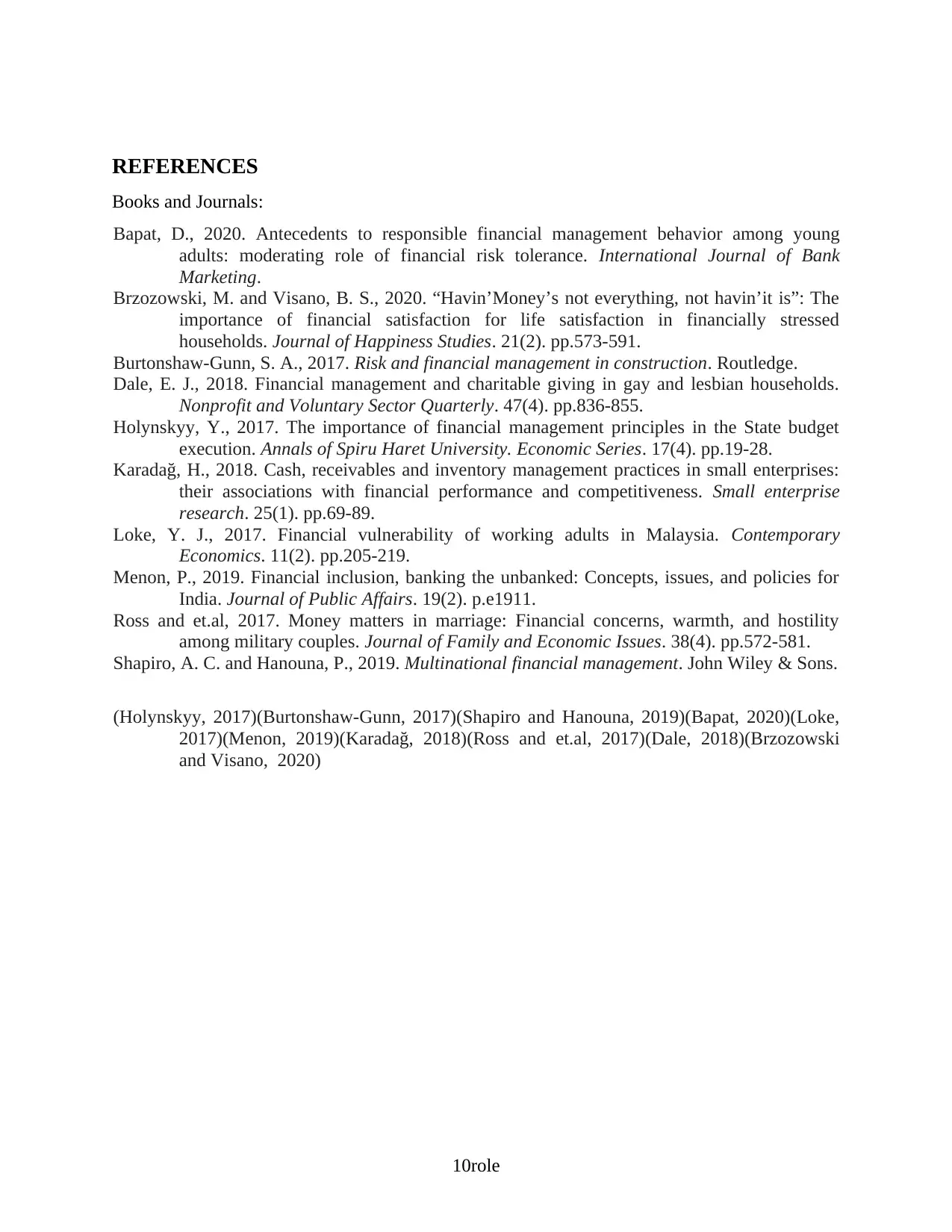
REFERENCES
Books and Journals:
Bapat, D., 2020. Antecedents to responsible financial management behavior among young
adults: moderating role of financial risk tolerance. International Journal of Bank
Marketing.
Brzozowski, M. and Visano, B. S., 2020. “Havin’Money’s not everything, not havin’it is”: The
importance of financial satisfaction for life satisfaction in financially stressed
households. Journal of Happiness Studies. 21(2). pp.573-591.
Burtonshaw-Gunn, S. A., 2017. Risk and financial management in construction. Routledge.
Dale, E. J., 2018. Financial management and charitable giving in gay and lesbian households.
Nonprofit and Voluntary Sector Quarterly. 47(4). pp.836-855.
Holynskyy, Y., 2017. The importance of financial management principles in the State budget
execution. Annals of Spiru Haret University. Economic Series. 17(4). pp.19-28.
Karadağ, H., 2018. Cash, receivables and inventory management practices in small enterprises:
their associations with financial performance and competitiveness. Small enterprise
research. 25(1). pp.69-89.
Loke, Y. J., 2017. Financial vulnerability of working adults in Malaysia. Contemporary
Economics. 11(2). pp.205-219.
Menon, P., 2019. Financial inclusion, banking the unbanked: Concepts, issues, and policies for
India. Journal of Public Affairs. 19(2). p.e1911.
Ross and et.al, 2017. Money matters in marriage: Financial concerns, warmth, and hostility
among military couples. Journal of Family and Economic Issues. 38(4). pp.572-581.
Shapiro, A. C. and Hanouna, P., 2019. Multinational financial management. John Wiley & Sons.
(Holynskyy, 2017)(Burtonshaw-Gunn, 2017)(Shapiro and Hanouna, 2019)(Bapat, 2020)(Loke,
2017)(Menon, 2019)(Karadağ, 2018)(Ross and et.al, 2017)(Dale, 2018)(Brzozowski
and Visano, 2020)
10role
Books and Journals:
Bapat, D., 2020. Antecedents to responsible financial management behavior among young
adults: moderating role of financial risk tolerance. International Journal of Bank
Marketing.
Brzozowski, M. and Visano, B. S., 2020. “Havin’Money’s not everything, not havin’it is”: The
importance of financial satisfaction for life satisfaction in financially stressed
households. Journal of Happiness Studies. 21(2). pp.573-591.
Burtonshaw-Gunn, S. A., 2017. Risk and financial management in construction. Routledge.
Dale, E. J., 2018. Financial management and charitable giving in gay and lesbian households.
Nonprofit and Voluntary Sector Quarterly. 47(4). pp.836-855.
Holynskyy, Y., 2017. The importance of financial management principles in the State budget
execution. Annals of Spiru Haret University. Economic Series. 17(4). pp.19-28.
Karadağ, H., 2018. Cash, receivables and inventory management practices in small enterprises:
their associations with financial performance and competitiveness. Small enterprise
research. 25(1). pp.69-89.
Loke, Y. J., 2017. Financial vulnerability of working adults in Malaysia. Contemporary
Economics. 11(2). pp.205-219.
Menon, P., 2019. Financial inclusion, banking the unbanked: Concepts, issues, and policies for
India. Journal of Public Affairs. 19(2). p.e1911.
Ross and et.al, 2017. Money matters in marriage: Financial concerns, warmth, and hostility
among military couples. Journal of Family and Economic Issues. 38(4). pp.572-581.
Shapiro, A. C. and Hanouna, P., 2019. Multinational financial management. John Wiley & Sons.
(Holynskyy, 2017)(Burtonshaw-Gunn, 2017)(Shapiro and Hanouna, 2019)(Bapat, 2020)(Loke,
2017)(Menon, 2019)(Karadağ, 2018)(Ross and et.al, 2017)(Dale, 2018)(Brzozowski
and Visano, 2020)
10role
⊘ This is a preview!⊘
Do you want full access?
Subscribe today to unlock all pages.

Trusted by 1+ million students worldwide
1 out of 13
Related Documents
Your All-in-One AI-Powered Toolkit for Academic Success.
+13062052269
info@desklib.com
Available 24*7 on WhatsApp / Email
![[object Object]](/_next/static/media/star-bottom.7253800d.svg)
Unlock your academic potential
Copyright © 2020–2025 A2Z Services. All Rights Reserved. Developed and managed by ZUCOL.



